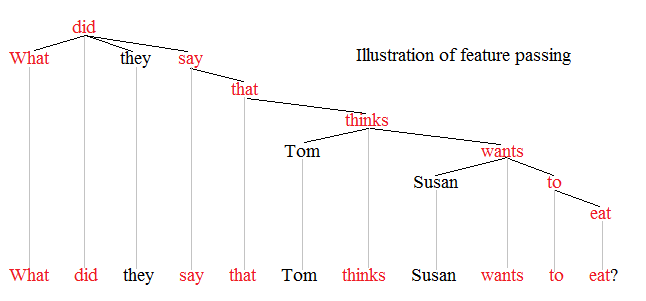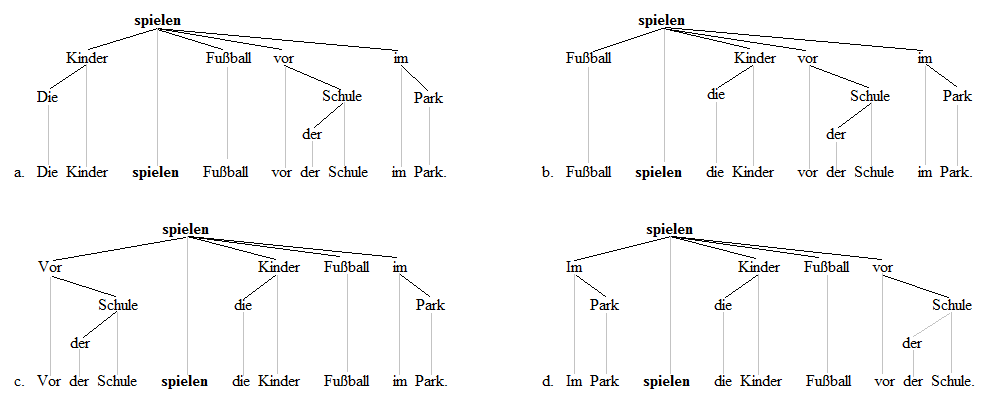|
Subject–auxiliary Inversion
Subject–auxiliary inversion (SAI; also called subject–operator inversion) is a frequently occurring type of inversion in English, whereby a finite auxiliary verb – taken here to include finite forms of the copula ''be'' – appears to "invert" (change places) with the subject. The word order is therefore Aux-S (auxiliary–subject), which is the opposite of the canonical SV ( subject–verb) order of declarative clauses in English. The most frequent use of subject–auxiliary inversion in English is in the formation of questions, although it also has other uses, including the formation of condition clauses, and in the syntax of sentences beginning with negative expressions (negative inversion). In certain types of English sentences, inversion is also possible with verbs other than auxiliaries; these are described in the article on subject-verb inversion. Overview Subject–auxiliary inversion involves placing the subject after a finite auxiliary verb, rather than before i ... [...More Info...] [...Related Items...] OR: [Wikipedia] [Google] [Baidu] |
Inversion (linguistics)
In linguistics, inversion is any of several grammatical constructions where two expressions switch their canonical order of appearance, that is, they invert. There are several types of subject-verb inversion in English: ''locative inversion'', ''directive inversion'', ''copular inversion'', and ''quotative inversion''. The most frequent type of inversion in English language, English is subject–auxiliary inversion in which an English auxiliaries, auxiliary verb changes places with its subject (grammar), subject; it often occurs in questions, such as ''Are you coming?'', with the subject ''you'' is switched with the auxiliary ''are''. In many other languages, especially those with a freer word order than English, inversion can take place with a variety of verbs (not just auxiliaries) and with other syntactic categories as well. When a layered phrase structure grammar, constituency-based analysis of sentence structure is used, inversion often results in the discontinuity (linguistic ... [...More Info...] [...Related Items...] OR: [Wikipedia] [Google] [Baidu] |
Indirect Question
In grammar, a content clause is a dependent clause that provides content implied or commented upon by an independent clause. The term was coined by Danish linguist Otto Jespersen. They are also known as noun clauses. English In English, there are two main kinds of content clauses: declarative content clauses (or ''that''-clauses), which correspond to declarative sentences, and interrogative content clauses, which correspond to interrogative sentences. Declarative content clauses Declarative content clauses can have a number of different grammatical roles. They often serve as direct objects of verbs of reporting, cognition, perception, and so on. In this use, the conjunction ''that'' may head the clause, but is often omitted: *''He told her (that) she was smart.'' *''She thought (that) he was friendly.'' *''I hear (that) they've started dating.'' *''They wish (that) they had met earlier.'' Similarly with certain verb-like adjectives: *''I'm not sure (that) he was right.'' *''C ... [...More Info...] [...Related Items...] OR: [Wikipedia] [Google] [Baidu] |
Dependency Grammar
Dependency grammar (DG) is a class of modern grammatical theories that are all based on the dependency relation (as opposed to the ''constituency relation'' of phrase structure) and that can be traced back primarily to the work of Lucien Tesnière. Dependency is the notion that linguistic units, e.g. words, are connected to each other by directed links. The (finite) verb is taken to be the structural center of clause structure. All other syntactic units (words) are either directly or indirectly connected to the verb in terms of the directed links, which are called ''dependencies''. Dependency grammar differs from phrase structure grammar in that while it can identify phrases it tends to overlook phrasal nodes. A dependency structure is determined by the relation between a word (a head) and its dependents. Dependency structures are flatter than phrase structures in part because they lack a finite verb phrase constituent, and they are thus well suited for the analysis of languages ... [...More Info...] [...Related Items...] OR: [Wikipedia] [Google] [Baidu] |
Syntactic Movement
Syntactic movement is the means by which some theories of syntax address discontinuities. Movement was first postulated by structuralist linguists who expressed it in terms of ''discontinuous constituents'' or ''displacement''. Some constituents appear to have been displaced from the position in which they receive important features of interpretation. The concept of movement is controversial and is associated with so-called ''transformational'' or ''derivational'' theories of syntax (such as transformational grammar, government and binding theory, minimalist program). Representational theories (such as head-driven phrase structure grammar, lexical functional grammar, construction grammar, and most dependency grammars), in contrast, reject the notion of movement and often instead address discontinuities with other mechanisms including graph reentrancies, feature passing, and type shifters. Illustration Movement is the traditional means of explaining discontinuities such as w ... [...More Info...] [...Related Items...] OR: [Wikipedia] [Google] [Baidu] |
Phrase Structure Grammar
The term phrase structure grammar was originally introduced by Noam Chomsky as the term for grammar studied previously by Emil Post and Axel Thue (Post canonical systems). Some authors, however, reserve the term for more restricted grammars in the Chomsky hierarchy: context-sensitive grammars or context-free grammars. In a broader sense, phrase structure grammars are also known as ''constituency grammars''. The defining trait of phrase structure grammars is thus their adherence to the constituency relation, as opposed to the dependency relation of dependency grammars. Constituency relation In linguistics, phrase structure grammars are all those grammars that are based on the constituency relation, as opposed to the dependency relation associated with dependency grammars; hence, phrase structure grammars are also known as constituency grammars. Any of several related theories for the parsing of natural language qualify as constituency grammars, and most of them have been develope ... [...More Info...] [...Related Items...] OR: [Wikipedia] [Google] [Baidu] |
Old English
Old English (, ), or Anglo-Saxon, is the earliest recorded form of the English language, spoken in England and southern and eastern Scotland in the early Middle Ages. It was brought to Great Britain by Anglo-Saxon settlement of Britain, Anglo-Saxon settlers in the mid-5th century, and the first Old English literature, Old English literary works date from the mid-7th century. After the Norman conquest of 1066, English was replaced, for a time, by Anglo-Norman language, Anglo-Norman (a langues d'oïl, relative of French) as the language of the upper classes. This is regarded as marking the end of the Old English era, since during this period the English language was heavily influenced by Anglo-Norman, developing into a phase known now as Middle English in England and Early Scots in Scotland. Old English developed from a set of Anglo-Frisian languages, Anglo-Frisian or Ingvaeonic dialects originally spoken by Germanic peoples, Germanic tribes traditionally known as the Angles, Sa ... [...More Info...] [...Related Items...] OR: [Wikipedia] [Google] [Baidu] |
Germanic Languages
The Germanic languages are a branch of the Indo-European language family spoken natively by a population of about 515 million people mainly in Europe, North America, Oceania and Southern Africa. The most widely spoken Germanic language, English, is also the world's most widely spoken language with an estimated 2 billion speakers. All Germanic languages are derived from Proto-Germanic, spoken in Iron Age Scandinavia. The West Germanic languages include the three most widely spoken Germanic languages: English with around 360–400 million native speakers; German language, German, with over 100 million native speakers; and Dutch language, Dutch, with 24 million native speakers. Other West Germanic languages include Afrikaans, an offshoot of Dutch, with over 7.1 million native speakers; Low German, considered a separate collection of Standard language, unstandardized dialects, with roughly 4.35–7.15 million native speakers and probably 6.7–10 million people who can understand ... [...More Info...] [...Related Items...] OR: [Wikipedia] [Google] [Baidu] |
V2 Word Order
In syntax, verb-second (V2) word order is a sentence structure in which the finite verb of a sentence or a clause is placed in the clause's second position, so that the verb is preceded by a single word or group of words (a single constituent). Examples of V2 in English include (brackets indicating a single constituent): * "Neither do I", " ever in my lifehave I seen such things" If English used V2 in all situations, the following would be correct: * " * n schoollearned I about animals", " * hen she comes home from worktakes she a nap" V2 word order is common in the Germanic languages and is also found in Northeast Caucasian Ingush, Uto-Aztecan O'odham, and fragmentarily in Romance Sursilvan (a Rhaeto-Romansh variety) and Finno-Ugric Estonian. Of the Germanic family, English is exceptional in having predominantly SVO order instead of V2, although there are vestiges of the V2 phenomenon. Most Germanic languages do not normally use V2 order in embedded clauses, with a few ex ... [...More Info...] [...Related Items...] OR: [Wikipedia] [Google] [Baidu] |
Possession (linguistics)
In linguistics, possession is an asymmetric relationship between two constituents, the referent of one of which (the possessor) in some sense possesses (owns, has as a part, rules over, etc.) the referent of the other (the possessed). Possession may be marked in many ways, such as simple juxtaposition of nouns, possessive case, possessed case, construct state (as in Arabic, and Nêlêmwa), or adpositions (possessive suffixes, possessive adjectives). For example, English uses a possessive clitic, '' 's''; a preposition, ''of''; and adjectives, ''my'', ''your'', ''his'', ''her'', etc. Predicates denoting possession may be formed either by using a verb such as English ''have'' or by other means, such as existential clauses (as is usual in languages such as Russian). Some languages have more than two possessive classes. In Papua New Guinea, for example, Anêm has at least 20 and Amele has 32. Alienable and inalienable There are many types of possession, but a common distincti ... [...More Info...] [...Related Items...] OR: [Wikipedia] [Google] [Baidu] |
Francis Thompson
Francis Joseph Thompson (16 December 1859 – 13 November 1907) was an English poet and Catholic mystic. At the behest of his father, a doctor, he entered medical school at the age of 18, but at 26 left home to pursue his talent as a writer and poet. He spent three years on the streets of London, supporting himself with menial labour, becoming addicted to opium which he took to relieve a nervous problem. In 1888 Wilfrid and Alice Meynell read his poetry and took the opium-addicted and homeless writer into their home for a time, later publishing his first volume, ''Poems'', in 1893. In 1897, he began writing prose, drawing inspiration from life in the countryside, Wales and Storrington. His health, always fragile, continued to deteriorate and he died of tuberculosis in 1907. By that time he had published three books of poetry, along with other works and essays. Early life and study Thompson was born in Winckley Street, Preston, Lancashire and baptized four days later in St ... [...More Info...] [...Related Items...] OR: [Wikipedia] [Google] [Baidu] |


.jpg)

.png)

